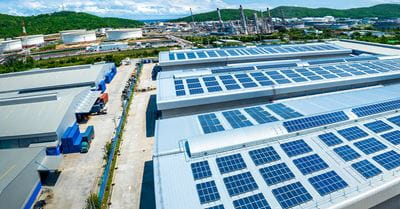5 Smart Tips For Warehouse Energy Cost Savings

From making small adjustments to larger investments in technology, we’ll take a look at how warehouses can operate more efficiently while also cutting down on energy expenses.
Operational costs are one of the most important factors to consider when running a business. Warehouse energy costs are especially high, and often involve a significant portion of any organization’s budget. Fortunately, there are many strategies that can help lower these costs. From making small adjustments to larger investments in technology, we’ll take a look at how warehouses can operate more efficiently while also cutting down on energy expenses.
Seal And Control Doors
One of the best places to start when trying to conserve energy in your warehouse is the loading dock. Adding seals or shelters to your dock doors can greatly reduce energy consumption by preventing outside air from getting in when trailers are being loaded or unloaded.
Installing high speed, insulated doors in other parts of your warehouse can also help. Doors with faster opening / closing cycles reduce air exchange because the doors don’t stay open as long.
Control Air Flow
When the heat is on in your warehouse in the winter, much of the heat escapes through the roof because warmer air rises. This air stratification can raise heating costs by as much as 25%. Using a destratification fan is an excellent way to instantly improve heating efficiency in your warehouse.
You can combat stratification by installing a high volume, low speed (HVLS) fan, and it’s an excellent way of regulating the flow of hot air throughout your warehouse. HVLS fans collaborate with your HVAC system to convey that warm air back to the ground, maintaining a steady temperature across the whole warehouse.
Invest in Efficient Lighting Solutions
If you’re not already doing so, it's a great idea to start using LED or fluorescent lighting in your warehouse. LEDs or fluorescents can quickly reduce energy expenditures by up to 80% versus standard incandescent lighting. In addition to using less energy than traditional incandescent lights, LED choices can also last up to 25% longer.
As an added benefit, high-quality lighting can boost staff productivity in addition to having a direct influence on energy expenses. A more comfortable, well-lit work environment can improve both morale and efficiency.
Consider Solar Panels
Solar panels have the potential to dramatically reduce a building's reliance on electricity during the clear months of the year. Most warehouses have expansive roofs that are ideal for solar applications.
In some circumstances, solar panels can generate enough energy reserves for use at night without using any electricity during the day. Some businesses even sell their excess energy back into the electrical system. While operating completely “off the grid” may not be feasible for a warehouse, solar energy can still help you reduce your costs.
Turn Off Machines When Not In Use
One of the most energy-inefficient practices among warehouse operators is to leave equipment running when it’s not in use. For instance, conveyor systems use a significant amount of energy when in use. However, some operators leave conveyors running idle for extended periods of time after each shift, adding up to a few hours of operation time every week.
If powered equipment can be turned off when not in use, it’s a good idea to do so. Putting equipment on an automatic timer can ensure that
Talk To A Warehouse Expert
If you would like to learn more about energy efficiency in your warehouse, contact Raymond West today. Our warehouse experts can help you identify savings opportunities and ways to make your operation more efficient.

